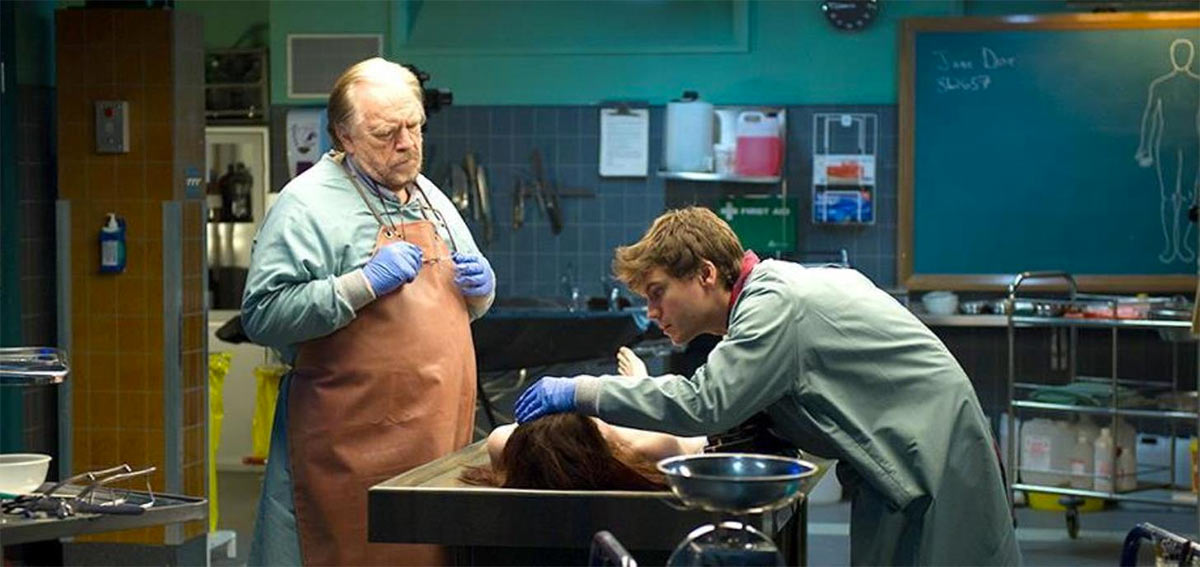Sometimes old tricks are the best tricks, especially when it comes to horror, and it seems André Øvreda knows this.
online pharmacy order nolvadex online best drugstore for you
It’s been six years since his last film, and for his latest he’s gone back to basics. The overt humor and found footage conceit of his excellent Trollhunter have been discarded in favor of more traditional horror movie tropes and techniques, which isn’t to say The Autopsy of Jane Doe is in any way generic. Far from it. Øvreda takes a brilliant and elegant premise — the kind of premise you’ll kick yourself for not thinking of — and builds a beautiful and unnerving old school spook-show around it.
We open on a blood bath. A family has been mysteriously slaughtered.
In the basement of the house, police discover a half-buried interloper: a young woman, naked, seemingly unharmed, but very much dead. The press want answers that the sheriff doesn’t have, so he carts the titular Jane Doe over to a local, family-owned morgue.
There, Tommy Tilden (Brian Cox) and his son Austin (Emile Hirsch) break out the scalpels and bolt cutters and start trying to figure out who this girl is and how she died.
So, the film starts off as something of a murder mystery, but as they continue to examine Jane Doe the Tilden boys start to realize that this was no ordinary crime. There are bizarre aspects to the body that reveal a history of impossible suffering and cruelty, and I really mean impossible. And, of course, as they disassemble Jane they inadvertently unleash all manner of supernatural nastiness.
In the name of said nastiness, Øvreda leans on the classic techniques. We’ve got radios going haywire and playing creepily “cheery” music. We’ve got doors closing and opening of their own accord. We’ve got jump scares. Heck, we’ve got ourselves a genuine Lewton bus, cat and all! Some people might dismiss this sort of stuff as clichéd and hokey, but Øvreda wields it with great skill. Sometimes clichés become clichés because they work. This is very effective horror filmmaking, crafted impeccably. I can count on one hand how many movies have put me literally on the edge of my seat and The Autopsy of Jane Doe is one of them.
But none of this craft and none of these scares would be worth a damn if it weren’t for the three central performances. I’m not one to subscribe to the conventional wisdom about likable characters in works of fiction.
online pharmacy order furosemide online best drugstore for you
Sometimes you just have to center your movie around a resolute asshole, but The Autopsy of Jane Doe shows that having likable leads really can add to a horror film. Cox and Hirsch bring tons of charm and charisma to their roles, and their father-son chemistry is wonderful. Their interactions feel natural and layered, as peppered with history and conflict as any familial relationship would be, but centered around care for each other and mutual respect. You really like these guys and you want them to make it through the night, no matter what Jane may have planned.
Speaking of which, that’s the third excellent performance: Olwen Kelly as Jane Doe. It may sound silly to praise the acting of a woman who spends the entire movie inert on a metal table, but really! From scene to scene, as her body is repositioned and shot in different ways, you really get the impression that Jane is an active, intelligent presence. In various contexts she seems vulnerable, in great pain, angry, determined. It’s a remarkably varied performance for a corpse, and I would be fascinated to learn what the working process was between Kelly and Øvreda. Even though for the bulk of the movie there are only two speaking roles, don’t be fooled. There’s always a third person in that room.
I do feel The Autopsy of Jane Doe loses its way slightly in its closing scenes, letting its heretofore smooth and natural doling out of information slump into naked exposition. What’s there is great on paper, thoughtfully tying together the film’s themes of regret and trauma, but the execution is lackluster and abrupt. But don’t let that keep you away from this film. In fact, I beg you to see it! We don’t get enough of this sort of thing: thoughtful, scary, well crafted horror, devoid of winking and nudging and gimmickry. André Øvreda has delivered an excellent slice of traditional genre cinema, and it deserves attention. Watch this movie. Cower under the covers. Support good horror.







